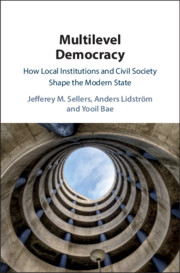Book contents
- Multilevel Democracy
- Multilevel Democracy
- Copyright page
- Epigraph
- Contents
- Figures
- Tables
- Acknowledgements
- Note on the Text
- 1 Introduction
- 2 Multilevel Democracy and the Modern State
- 3 Multilevel Democracies
- 4 Trajectories of Local State Formation
- 5 The Local State and the Formation of Civil Society
- 6 The Policy State and Local Governance
- 7 The Quality of Multilevel Democracy
- Postscript
- Appendix Cluster Analysis of Institutional Indicators
- References
- Index
5 - The Local State and the Formation of Civil Society
Published online by Cambridge University Press: 11 February 2020
- Multilevel Democracy
- Multilevel Democracy
- Copyright page
- Epigraph
- Contents
- Figures
- Tables
- Acknowledgements
- Note on the Text
- 1 Introduction
- 2 Multilevel Democracy and the Modern State
- 3 Multilevel Democracies
- 4 Trajectories of Local State Formation
- 5 The Local State and the Formation of Civil Society
- 6 The Policy State and Local Governance
- 7 The Quality of Multilevel Democracy
- Postscript
- Appendix Cluster Analysis of Institutional Indicators
- References
- Index
Summary
Throughout Europe, North America, and Japan, the era that has come to be known as the long nineteenth century was a period of growth in civic, political, and economic associations (Hoffmann, 2003). Even in industrialized societies that only later became established democracies, many of the leading political parties, organized economic interests, and civic organizations of today trace their founding to this era. Middle- and working-class movements mobilized, organized electoral competition diffused increasingly across borders, and political interests organized around the economic and social structures of industrial capitalism (e.g., Bartolini, 2000, Tarrow, 1994, Katznelson and Zolberg, 1986). The wider societal shifts that contributed to civic formation, from urbanization to the spread of literacy and the rise of professionalized middle classes (Bermeo and Nord, 2000, Morton et al., 2006), also played out at the local scale. The emergent multilevel state largely preceded and helped give shape to these transformations, even as its own architecture increasingly reflected their influence. An increasingly vast literature has examined these developments through a variety of lenses, from general historical overviews of civic associational development to more focused accounts of the emergence of consociational democracy, political party systems, and organized business associations and working-class movements.
- Type
- Chapter
- Information
- Multilevel DemocracyHow Local Institutions and Civil Society Shape the Modern State, pp. 202 - 260Publisher: Cambridge University PressPrint publication year: 2020

